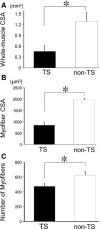Stand-up exercise training facilitates muscle recovery from disuse atrophy by stimulating myogenic satellite cell proliferation in mice
- PMID: 25367692
- PMCID: PMC4255801
- DOI: 10.14814/phy2.12185
Stand-up exercise training facilitates muscle recovery from disuse atrophy by stimulating myogenic satellite cell proliferation in mice
Abstract
Determining the cellular and molecular recovery processes in inactivity - or unloading -induced atrophied muscles should improve rehabilitation strategies. We assessed the effects of stand-up exercise (SE) training on the recovery of atrophied skeletal muscles in male mice. Mice were trained to stand up and press an elevated lever in response to a light-tone cue preceding an electric foot shock and then subjected to tail suspension (TS) for 2 weeks to induce disuse atrophy in hind limb muscles. After release from TS, mice were divided into SE-trained (SE cues: 25 times per set, two sets per day) and non-SE-trained groups. Seven days after the training, average myofiber cross-sectional area (CSA) of the soleus muscle was significantly greater in the SE-trained group than in the non-SE-trained group (1843 ± 194 μm(2) vs. 1315 ± 153 μm(2)). Mean soleus muscle CSA in the SE trained group was not different from that in the CON group subjected to neither TS nor SE training (2005 ± 196 μm(2)), indicating that SE training caused nearly complete recovery from muscle atrophy. The number of myonuclei per myofiber was increased by ~60% in the SE-trained group compared with the non-SE-trained and CON groups (0.92 ± 0.03 vs. 0.57 ± 0.03 and 0.56 ± 0.11, respectively). The number of proliferating myonuclei, identified by 5-ethynyl-2'-deoxyuridine staining, increased within the first few days of SE training. Thus, it is highly likely that myogenic satellite cells proliferated rapidly in atrophied muscles in response to SE training and fused with existing myofibers to reestablish muscle mass.
Keywords: 5‐ethynyl‐2’‐deoxyuridine; myogenic satellite cells; myonuclei; operant conditioning; stand‐up exercise.
© 2014 The Authors. Physiological Reports published by Wiley Periodicals, Inc. on behalf of the American Physiological Society and The Physiological Society.
Figures





Similar articles
-
Training at non-damaging intensities facilitates recovery from muscle atrophy.Muscle Nerve. 2017 Feb;55(2):243-253. doi: 10.1002/mus.25218. Epub 2016 Nov 7. Muscle Nerve. 2017. PMID: 27301985
-
β-Hydroxy-β-methylbutyrate (HMB) enhances the proliferation of satellite cells in fast muscles of aged rats during recovery from disuse atrophy.Exp Gerontol. 2013 Sep;48(9):973-84. doi: 10.1016/j.exger.2013.06.005. Epub 2013 Jul 4. Exp Gerontol. 2013. PMID: 23832076
-
Treadmill training does not enhance skeletal muscle recovery following disuse atrophy in older male mice.Front Physiol. 2023 Oct 24;14:1263500. doi: 10.3389/fphys.2023.1263500. eCollection 2023. Front Physiol. 2023. PMID: 37942230 Free PMC article.
-
Mechanisms leading to restoration of muscle size with exercise and transplantation after spinal cord injury.Am J Physiol Cell Physiol. 2000 Dec;279(6):C1677-84. doi: 10.1152/ajpcell.2000.279.6.C1677. Am J Physiol Cell Physiol. 2000. PMID: 11078681
-
Skeletal muscle wasting with disuse atrophy is multi-dimensional: the response and interaction of myonuclei, satellite cells and signaling pathways.Front Physiol. 2014 Mar 17;5:99. doi: 10.3389/fphys.2014.00099. eCollection 2014. Front Physiol. 2014. PMID: 24672488 Free PMC article. Review.
Cited by
-
Lemon Myrtle (Backhousia citriodora) Extract and Its Active Compound, Casuarinin, Activate Skeletal Muscle Satellite Cells In Vitro and In Vivo.Nutrients. 2022 Mar 4;14(5):1078. doi: 10.3390/nu14051078. Nutrients. 2022. PMID: 35268053 Free PMC article.
-
Lower limb muscle strengthening exercises in patients with early-stage amyotrophic lateral sclerosis: a case series study.J Phys Ther Sci. 2020 Oct;32(10):615-620. doi: 10.1589/jpts.32.615. Epub 2020 Oct 3. J Phys Ther Sci. 2020. PMID: 33132518 Free PMC article.
-
Effect of Silymarin Supplementation on Physical Performance, Muscle and Myocardium Histological Changes, Bodyweight, and Food Consumption in Rats Subjected to Regular Exercise Training.Int J Mol Sci. 2020 Oct 19;21(20):7724. doi: 10.3390/ijms21207724. Int J Mol Sci. 2020. PMID: 33086540 Free PMC article.
-
Voluntary stand-up physical activity enhances endurance exercise capacity in rats.Korean J Physiol Pharmacol. 2016 May;20(3):287-95. doi: 10.4196/kjpp.2016.20.3.287. Epub 2016 Apr 26. Korean J Physiol Pharmacol. 2016. PMID: 27162483 Free PMC article.
References
-
- Antonio J., Gonyea W. J. 1993a. Skeletal muscle fiber hyperplasia. Med. Sci. Sports Exerc.; 25:1333-1345. - PubMed
-
- Antonio J., Gonyea W. J. 1993b. Progressive stretch overload of skeletal muscle results in hypertrophy before hyperplasia. J. Appl. Physiol.; 75:1263-1271. - PubMed
-
- Bischoff R. 1989. Analysis of muscle regeneration using single myofibers in culture. Med. Sci. Sports Exerc.; 215 Suppl:S164-S172. - PubMed
-
- Bruusgaard J. C., Egner I. M., Larsen T. K., Dupre‐Aucouturier S., Desplanches D., Gundersen K. 2012. No change in myonuclear number during muscle unloading and reloading. J. Appl. Physiol.; 113:290-296. - PubMed
LinkOut - more resources
Full Text Sources
Other Literature Sources

